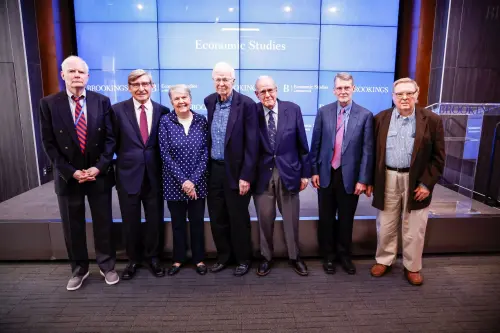President-elect Barack Obama says he will create or protect some three million jobs by spending a massive amount of federal dollars to build roads and other “shovel ready” government projects across the country. The projects in this economic stimulus package, he says, will “not be based on politics and lobbying.”
Nice thought. But already Mr. Obama is facing pressure by public officials from coast to coast to run in the other direction. In recent weeks, for example, the U.S. Conference of Mayors forwarded to Congress a list of 11,391 infrastructure projects that, we are to believe, are “ready to go.” Several media outlets quickly pointed out that this list is full of pork — the most flagrant examples are a polar-bear exhibit, an antiprostitution program, and a water-park ride. The nation’s governors, transit officials, and the American Association of State Highway and Transportation Officials have sent along their own lists, which are likely to contain their own “bridges to nowhere.”
But the deepest problem Mr. Obama faces is not the diversion of funds to pork-barrel projects — contrary to popular belief, this generally amounts to a modest share of public expenditures. The problem is rather that infrastructure spending itself is productive only when it produces a large social return.
If Mr. Obama is to make good on his promise to stimulate the nation’s economy by firing up the nation’s steamrollers, cement trucks and the like, the challenge is to find a way to make run-of-the-mill projects cost effective while also cutting the cost and time of travel. In other words , he needs to wring wasteful spending not just out of pork projects, but out of all of his transportation spending as well.
Critically, his administration needs to face the problem that those who use roads, bridges and airports do not pay for the full cost of maintenance, nor do they pay for the cost they impose on other travelers by contributing to congestion. Those who use public buses and trains have long been heavily subsidized to encourage ridership.
When travelers don’t pay for the full cost of their use of the transportation system, policy makers are left with the impression that new roads, airports and urban rail systems should be built to cut down on congestion. But if prices were aligned with actual costs (through tolls), demand would fall. This would especially be true during peak travel periods, and therefore public expenditures would not be wasted on dubious projects.
One of the biggest killers of all is that states insist on allocating federal transportation funds through a politically devised formula. The result? Smooth, well-paved rural highways and worn-out urban roadways that are paved with a layer of asphalt too thin to withstand heavy use and are therefore in need of excessive, costly maintenance.
But don’t blame the states for all the inefficient use of highway dollars. Federal regulations have also inflated the cost of providing roads, trains and so much more for a public on the move.
It takes the nation’s busiest airports decades and billions of dollars to build new runways, for example, because of onerous regulations imposed by the Federal Aviation Administration and the Environmental Protection Agency. Davis-Bacon mandates, which effectively require that “prevailing” union wages (often much higher than the actually prevailing market wage) be paid to workers on any construction project receiving federal funds, also drive up the costs of roads and other federal transport projects. The Federal Transit Act also makes it extremely expensive to lay off transit employees.
All of this wouldn’t be so bad if even inflated costs brought back large returns. In co-authored peer-reviewed research, I’ve published two papers on this subject in recent years in the Journal of Urban Economics. What I found was that over the past decade we have reaped a mere 1% return on our highway investments. And what’s more, for every $1 the government has spent trying to reduce roadway congestion, motorists have saved a mere three cents in travel time and other costs.
The wish lists that special interest groups are lobbying Congress to stuff into Mr. Obama’s stimulus package do nothing to move us away from the over-priced, low social-benefit projects of the past.
Instead of funding every special-interest pet project, the incoming administration would be better served by taking a two-step approach. First, work with Congress to address things that can reduce costs in the short run. Reforming Davis-Bacon, for example, would be a good start. Second, formulate a carefully considered set of infrastructure investments that are likely to generate the largest benefits to the traveling public, while boosting employment.
In my view, such investments are likely to include building additional runways at congested airports and expanding highways in the most congested metropolitan areas where land is available to do so. The benefits from such investments will be greater if the driving and flying public are charged prices that actually reflect the costs that they incur.
Unlike the bailout of the financial system, sound economic guidelines do exist to enable the Obama administration to develop a successful infrastructure stimulus package to help address the current crisis. The country would best be served if those guidelines are followed.



Commentary
Op-ed“Stimulus” Doesn’t Have to Mean Pork
December 28, 2008